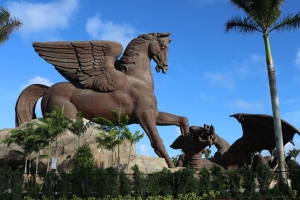Thoroughbred Racing Fan Association, Inc.

Thoroughbred Racing Fan Association, Inc.


STRONACH HAD IT RIGHT WITH THE PEGASUS
1/30/2023
Unlike most professional sport athletes our equine athletes make infrequent appearances like the ground hog in the winter. Remembering them takes work unless they are recognizable for performance and contribute ink to the front pages of sports media. Even professional football players in the NFL (“Not For Long”) give their fans more exposure than the average race horse. Racing has tried, usually with little success, to change that. The seduction for high profit stud duty, lures them away. It is pure economics, just follow the money. Even with $3,000,000 purses like that offered in this weekend’s Pegasus World Cup Invitational (GI) it could only lure four from the 2022 3-year-old crop to come back to run in the race --- Simplification, White Abarrio, Skippylongstocking and Cyberknife. The listing those that opted for stud duty would be an encyclopedic effort.
Eight years ago, Frank Stronach proposed a new race to be run in January with a purse of $12 million. His primary goal may have been to have a race on his track that had the largest purse in the United States and perhaps the world. Functionally, the dollar signs awoke connections of 3-year-old champions with a reason to run as 4-year-olds.
If you are a college basketball fan you see how teams get high ranks in the coaches polls. They are multidimensional teams with good players in every position both on the floor and on the bench. The teams with one superstar get media attention but rarely build a team when their superstar is an early NBA draft pick. This single-dimensional roster drives marketing and revenues for the team and the school, but little else.
Racing needs to understand this. Racing needs a way to showcase all our assets---horses, jockeys, trainers, and fans. Sending horses to the breeding shed only after a year or two of public exposure doesn’t help racing. Not promoting the athleticism and skills of jockeys at all levels and genders doesn’t either. Many trainers journey for years to win major races while only the most media savvy are household names like Baffert, Brown and Pletcher. Fans lack exposure except for social media posts of the excitement of winning a bet. The model needs tweaking.
The innovative idea by Frank Stronach eight years ago to create the Pegasus World Cup Invitational Race (GI) made a difference, albeit small. Unfortunately, the industry did not sufficiently embrace it. The original purse money of $12 million after jutting up to $18 million sped like a sprinter out of the gate to $3 million in four years and remained. Meanwhile the Breeders’ Cup has grown in popularity and purse money, often times as the “goodbye races” for great equine athletes before they are shuttled off to breeding sheds. We shouldn’t be shocked; it has been the industry’s practice for decades and yet, we wonder why racing isn’t growing its fan base.
We are not naïve. We understand the tremendous pull on owners and breeders to get their horses into procreation mode and their progeny into the sales ring. Racing benefits from this model by filling future race cards. Yet, why can’t this change without undermining the financial impact and future field size? The profits from breeding wouldn’t likely be damaged by a 12-month delay in breeding, if incentives were in place. To mitigate injuries in racing for those 4-year-olds couldn’t an insurance policy be purchased. Perhaps purse money for races for older horses could be increased like Stronach hoped for to entice continued racing. There may be many other options racing could take to keep our stars, heroes and marketers in racing, if for just one more year. Although it has been tried before, it is not a reason to try it again.
In the seventies Secretariat raced 21 times in his 2 and 3-year-old career. Affirmed raced 29 times, winning six races as a 4-yearold. In the sixties Dr. Fager raced 27 times winning seven races as a 4-year-old. These are just a few. Racing can’t mandate that owners run their horses more than they want, but it can offer incentives in purse money or bonuses that make the decision to breed or to race one more year a more difficult financial decision. Now it is not. Breeding farms control the algorithm which competes against the best interest of the sport and its fan base. Even at the lower level of horseracing breeding isn’t aligned as evidenced by the demand for aftercare horse facilities needed. The Jockey Club Fact Book evidences this concern. In 2015, 21,525 foals registered to race. When this crop turned 3-years-old only 34.5% ((7,426) raced ---65.5% didn’t. In 2014, 21,427 horses were foaled with only 4.56% (977) raced when they were 4 years old ---95.44% didn’t. Although many factors may have influenced these data, low percentages of foals racing at 4 should raise fundamental questions for the future popularity of our sport.
Frank Stronach understood where these numbers were trending and the impact it might have on our sport when in 2016, he proposed the Pegasus. He understood the finances of racing by incentivizing owners to keep their best horses in the game for at least one more year, or a part of it. In last Saturday’s Pegasus only 4 horses from the 2020 foal crop showed-up to help keep our sport and Stronach’s dream alive. Of these four only two have a notch in their grad one belt---White Abarrio (Fountain of Youth) and Cyberknife (Haskell Stakes). Can’t we do better? Or sport and its fans deserve better.